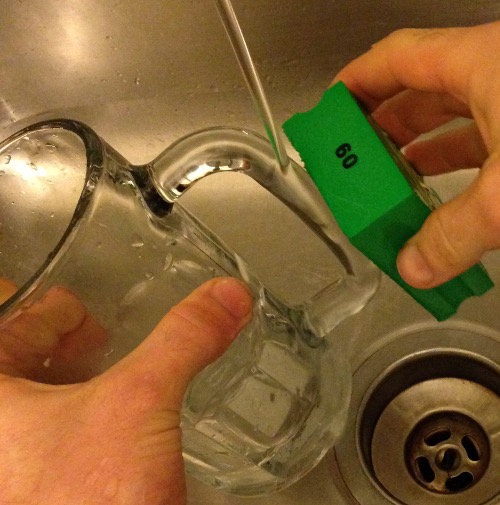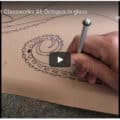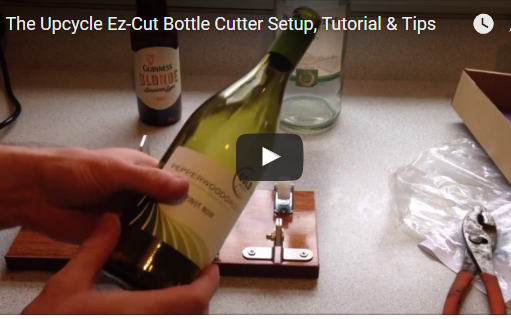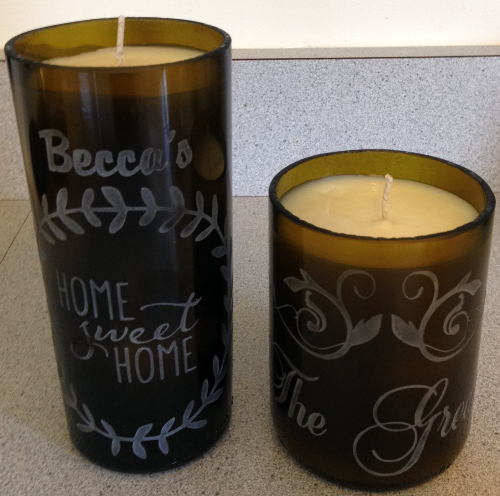In the previous post, I created a video on how to cut a wine bottle and included plans on making a cutter yourself. I hope you enjoyed that project idea.
I didn’t really talk much about sanding the edges smooth where the bottle was cut. Most people use sandpaper to smooth these by hand sanding the edges. Well, I thought of an even better idea which is included in the video below with a rotary drum sanding wheel.
As discussed in the video, listed below are some of the sanding drum wheels I found:
- 26 piece drill attachment drum kit: http://amzn.to/2h5ytPa
- 26 piece drill attachment drum kit: http://amzn.to/2h46nSI
Sanding Tips & Safety
In the video, there are some things I forgot to mention.
- Sand Paper Types for Glass: Most sanding paper or drum wheels use aluminum oxide which works for glass, but there are premium types of sandpaper that work even better. Silicon carbide sandpaper or diamond grit wheels are 2 types that works better.
- Glass Dust Safety Issue: Sanding glass can make silica airborne and breathed in which causes a serious health problem known as silicosis. Using a fast moving rotary drum wheel will release even more. To combat this, most people either sprinkle on water while they are sanding or dip the paper in a bucket of water occasionally. The water will prevent the dust from getting in the air. You can also use a quality dust mask.
- Grits: When sanding, it’s best to use at least 2-3 different grit sandpapers. Start with a course grit such and finish with a fine grit. I only used 120 grit to finish, but that isn’t very fine. Use up to 400 grit for a smoother finish.
Note: Also see our branded bottle cutter with the basic kit here and the deluxe kit here.
If you have a question or suggestion, please post a comment below. Thanks!
Share this on social media or email by clicking below!





This tool seems really great. Your personalized-works also! You really inspire me to be a glass artist, but this is a too much luxury for conditions of Turkey :)Many thanks for the video, keep producing good-quality art-job. Best regards,
Eric,
Great tip! Another way to smooth the rim is to incorporate your etching design that will include frosting the rim, or taping off a decorative band or ring at the top.
You can also check out a diamond sanding block used to de-burr the edge of a ceramic tile. They can be found in the tile cutting and grout applying supplies at hardware or tile stores.
Our old friend “Harbor Freight ” has diamond grinding tool including little barrel sanders for dremel tools. I also have found them on Ebay under search “Dremel tool”.
Keep the tips coming!
Ernie
Thank you very much for you tips they are simple and help a lot again thank you
Thanks — very helpful. Have struggled with getting bottle glasses smoothed at the rim. Nicely presented. Mea
Are U using any type of protection ? What about glass dust that can be breath in to your lungs ? Just asking I heard it could be dangerous .
Hi Eric – do you ever want or need to polish your glass to give it an optimal shine or feel? I’m thinking about polishing my glass vases that I’ve etched into, but I’m not sure which accessories to use for that. Do you have any recommendations? I saw some polishing accessories by Dremel like the brushes or wheels, but not sure if they would do the trick.
Thank you!
I do have a question: What is the name of the sanding utensil you used at the end for final buffing/smoothing? Looks like a starfish or something?
@ Chris- it’s just a piece of finer sandpaper. It was a leftover sandpaper disc used at the bottom of a floor sander. I used it to redo my wood floors. Any sand paper should work.
Hi I tried with this with the Dremel I don’t is wine but beer bottles. It completely chips all around the edges and ruins the finish. Do you have any advice for me?
Thanks
@ Natasha,
Yes, it the sanding drum is chipping at the edges, I suggest you use sandpaper with a finer grit. That should solve your problem. Thanks
thank you i will try that, not with the dremel, i think the bigger tool you used will probably be more effective, dremel is too small and works in one area but not the whole thing evenly.
Are there long term health effects with sanding bottles? I have a small business and have sanded several bottles before being made aware of the health effects of silica. Since then I use a mask and do better house keeping but I am still concerned with cutting/sanding bottles. The silica in bottles (dust) can be very dangerous. What are your recommendations? Thanks!
Brenda
I invested in a small sandblasting cabinet (~£120 UK). It doubles up as I use a sand blasting technique for etching, and I can sand in side it too. Don’t be tempted to buy a cheaper inflatable version….they don’t last or give adequate protection.
Protect your lungs…you only get one set of your own!
Protect your hands wear appropriate gloves.. fine glass can get rubbed into the skin and cause irritation.
Can you use only the diamond drums or do I have to buy the others?
@Marie, you can use any type- the diamond drums I found would have just sanded quicker. It looks like they aren’t available anymore so I removed the link.
that’s fast and easy its a excellent work what kind of a sand blaster is used
Does this get the bottle very smooth? I have been using silicone carbide and sanding against a metal surface and finishing up with sand paper. Though extremely exhausting it gets the job done quite well. Just wondering how good the finish can be made with this method? Thanks!
Hi ,I am looking for the fastest way for polishing the bottle’s edges . Most of the video that i found ,are using hand wet paper sand with different grits . What if I make a sanding drum paper and sanding disc pad wet on drill? Is it dangerous to use wet drum paper or wet sanding disc on electrical device (drill or rotary )?
Where I’ve sanded my colored glass, the sanded areas are now white. I’ve tried fine grit sandpaper, baking soda paste, and it’s still there. How to make it shiny, not white-scuffed looking?
@Angie, I don’t have a lot of experience sanding out the glass enough to remove the white etching, but it may be possible with a lot of fine grit glass polishing compound. After sanding it down with at least 400 grit, you might want to use these polishes in order:
First: 2.3 micron compound: https://amzn.to/2PwbBYY
Second if it still isn’t fixed: 1.2 micron compound: https://amzn.to/2BQhGrn
You will want to use a felt polishing pad hooked up to a drill.